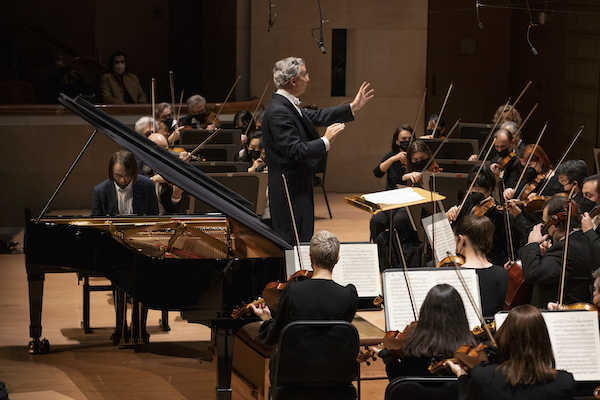Luisi leads DSO in dramatic Brahms and a Schmidt rarity

Thursday night’s Dallas Symphony Orchestra concert was one with themes of anguish, introspection, and acceptance running through its center. With DSO music director Fabio Luisi leading, and in partnership with guest soloist Daniil Trifonov, the Meyerson Symphony Center saw an evening of discerning musicality and refinement, enough to match the subject matter’s gravity and communicative power.
Johannes Brahms was 21 years old when, in February of 1854, his beloved mentor and fervid advocate Robert Schumann jumped from a bridge into the Rhine . His suicide attempt was the beginning of a swift decline in Schumann’s mental and physical health; he would be institutionalized in an asylum where he would spend the remaining two years of his life. Having quickly grown close to the Schumann family, Brahms devoted himself to the care of Clara, Robert’s wife, and their seven children following the breakdown. Indeed, it was the Schumann’s public endorsement that, virtually overnight, catapulted Brahms into artistic prominence.
It was a burgeoning adoration of Clara and the immense weight of losing his friend and father figure that marked this two-year chapter of Brahms’ life and served as the emotional impetus for his Piano Concerto No. 1. What began as a sonata for two pianos would eventually become a record of these tumultuous years—part elegy, part declaration—with piano as the leading voice.
Trifonov moved through the shifting moods of the opening Maestoso with assuredness. Gentle lyricism juxtaposed flexible bursts of octaves and trills, capturing the score’s emotional directness. While the movement’s tempo was taken a bit more slowly than usual, Luisi drew striking ensemble tuttis with consistent, understated accompaniment.
The handsomely shaded Adagio was both ireverential and confessional in mood. Trifonov brought a lush sentiment though was occasionally buried under the winds and strings. Still, the soloist conveyed the rich, complex emotions of the slow movement, with Luisi and the DSO matching Trifonov in sensitivity. The colossal finale was cinematic and turbulent, with a near-perfect rush to the finish, save some rhythmic stumbling between brass and strings.
Like Brahms, Slovakian composer Franz Schmidt was also no stranger to the vicissitudes associated with having a mentally-ill loved one. After 20 years of marriage, his wife’s mental instability necessitated her institutionalization in an Austrian asylum. It wasn’t until after his death, though, in 1939, that she was murdered by the National Socialist government as part of the Nazis’ euthanasia program.
In 1932 Schmidt’s only child, Emma died in childbirth at the age of 30. Thoroughly imbued with grief and solemnity, Franz Schmidt’s Fourth is the pinnacle of his symphonic settings and is, by his own inscription, a requiem for his daughter.
A blending of four-movement symphonic form, No. 4 is set as one large-scale movement, with each of the four distinct sections conjoined and played attaca.
An unaccompanied solo trumpet opens the work with its principal theme, which was delivered here with mourning and mystery by DSO acting principal L. Russell Campbell. As the movement blossomed, with pulsing percussion and strings, Luisi’s restraint tempered the emotional excess, achieving an effect that was sober but not yet despairing.
The slower second movement dirge saw tasteful blend and dynamic swells from the ensemble, along with more exquisite solo playing from associate principal cellist Theodore Harvey, English hornist David Matthews, and concertmaster Alexander Kerr.
After a hurried fugue, which constitutes the third movement, solo horn and subtly rolling percussion ushered in the finale on the opening theme, leading to a proliferation in the orchestral texture that was lush with harmony. Luisi and the DSO captured the essential dichotomy of loss and liberation from Schmidt’s score, with the piece closing as it began—with the solo trumpet playing the principal theme. This time, however, mourning feels more like understanding.
The program will be repeated 7:30 p.m. Friday and Saturday, and 3 p.m. Sunday. dallassymphony.org


